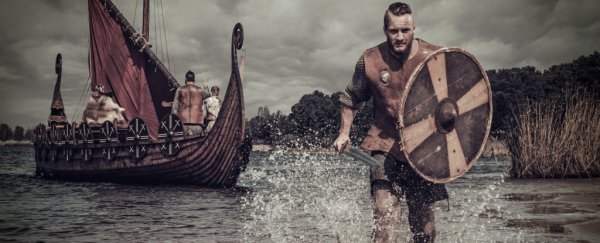If there's one thing nearly everyone knows about the Vikings, it's that they loved to hit the high seas for a bit of raiding, pillaging, and plundering of European towns. But why? What was the point of all this endless conquest?
Multiple hypotheses have been put forward - perhaps bountiful harvests produced a population boom that triggered raiding groups to leave Scandinavia - but new research favours a completely different reason: sex.
Back in the day of the Vikings - which stretched from about 750 to 1050 AD - many groups practised polygyny.
Viking societies were just as complex as ours are today, with a hierarchy based on who had the most wealth - and the richest and most powerful of Viking men tended to have many wives and concubines.
So researchers are now looking into the possibility that young Vikings went in search of additional wives to assert their status.
The team's hypothesis is backed up by archaeological finds, such as ancient mass graves and Nordic stories called sagas that have been dated to the era.
These mass graves were commonly found to be full of young men, and based on weapons and other loot found in archaeological dig sites, researchers know that goods and slaves were the most sought-after bounty for these raiders - a fact that's recounted in sagas.
These goods and slaves were likely used to increase power, which, in turn, increased the likelihood of multiple marriages.
"I'd like people to keep in mind that the Vikings weren't particularly unusual in engaging in concubinage and polygyny, or in going raiding. Plenty of societies in the past approved of polygynous relationships - indeed, some still do in the present day," one of the team, Mark Collard from Simon Fraser University in Canada, told Charles Q. Choi at Live Science.
"Similarly, raiding was not unusual in the past and remains fairly common today in certain places. So, while the Vikings can seem exotic, it's a mistake to view them that way. They weren't outliers when it comes to human behaviour."
In other words, just like people today gather material items - cars, a house, the new iPhone - to achieve a social certain status, so did Vikings. Except one of those was wives.
According to the team, this type of marriage likely created a shortage of eligible women, because powerful men married many of them, leaving the average Viking man wifeless.
This 'monopolisation' of women forced the regular men to get a bit feisty, the team says, causing many of them to perform riskier and riskier things to gain enough wealth and power to find a suitable match - or, matches because, you know, polygyny.
"Because polygynous marriage increases male-male competition by creating a pool of unmarried men, its occurrence within a society is predicted to increase risky status-elevating and sex-seeking behaviours among men, potentially leading to increased rates of murder, theft, rape, social disruption, kidnapping (especially of women), sexual slavery, prostitution, and - among high-status men - risky bids for political power."
The team also notes that powerful men - those who already had plenty of wives and riches - likely joined in on these raids as well, providing leadership, funding, and other support to the younger bands of raiders while reaping even more wealth for themselves along the way.
In fact, even young women were thought to join in on raiding because it was a viable way of life, producing power and influence in an extremely competitive culture, though little is understood about the motivations of women, besides raiding just being the popular thing for all Vikings to do.
"We're not saying that every Viking went raiding," Collard notes to Live Science. "Many did; others didn't. Social life in the Viking Age would have been as complicated as social life in the present day."
Despite the rather diverse bands of raiders, most of them were still young men who - if the team is correct - needed to find a way to quickly gain power and prestige in a society where a mate was hard to find.
Hopefully, as more archaeological digs continue to reveal new details about the fascinating culture of the Vikings, we will eventually have a complete story but only time will tell.
The team's work was published in Evolution and Human Behaviour.
